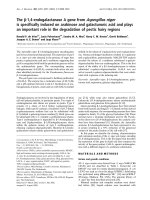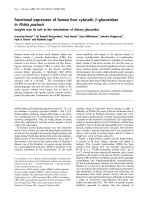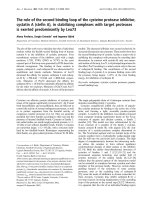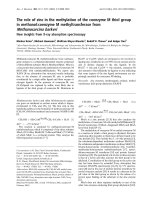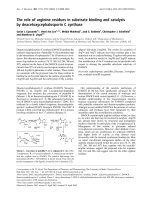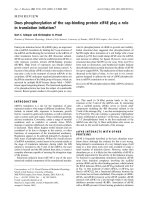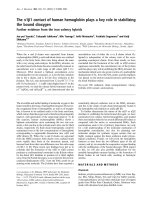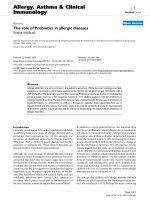Báo cáo Y học: The role of zinc in the methylation of the coenzyme M thiol group in methanol:coenzyme M methyltransferase from Methanosarcina barkeri New insights from X-ray absorption spectroscopy doc
Bạn đang xem bản rút gọn của tài liệu. Xem và tải ngay bản đầy đủ của tài liệu tại đây (342.54 KB, 7 trang )
The role of zinc in the methylation of the coenzyme M thiol group
in methanol:coenzyme M methyltransferase from
Methanosarcina barkeri
New insights from X-ray absorption spectroscopy
Markus Kru¨er
1
, Michael Haumann
2
, Wolfram Meyer-Klaucke
3
, Rudolf K. Thauer
1
and Holger Dau
2
1
Max-Planck-Institut fu
¨
r terrestrische Mikrobiologie and Laboratorium fu
¨
r Mikrobiologie, Fachbereich Biologie der Philipps-
Universita
¨
t, Marburg, Germany;
2
Freie Universita
¨
t Berlin, Fachbereich Physik, Berlin, Germany;
3
DESY, EMBL Outstation, Hamburg, Germany
Methanol:coenzyme M methyltransferase from methano-
genic archaea is a cobalamin-dependent enzyme composed
of three different subunits: MtaA, MtaB and MtaC. MtaA is
a zinc protein that catalyzes the methylation of coenzyme M
(HS-CoM) with methylcob(III)alamin. We report zinc
XAFS (X-ray absorption fine structure) results indicating
that, in the absence of coenzyme M, zinc is probably
coordinated by a single sulfur ligand and three oxygen or
nitrogen ligands. In the presence of coenzyme M, one
(N/O)-ligand was replaced by sulfur, most likely due to
ligation of the thiol group of coenzyme M. Mutations in
His237 or Cys239, which are proposed to be involved in
ligating zinc, resulted in an over 90% loss in enzyme activity
and in distinct changes in the zinc ligands. In the
His237 fi Ala and Cys239 fi Ala mutants, coenzyme M
also seemed to bind efficiently by ligation to zinc indicating
that some aspects of the zinc ligand environment are sur-
prisingly uncritical for coenzyme M binding.
Keywords:
11
zinc enzymes; methanogenic archaea; methyl
transferases; thiol group alkylation; EXAFS.
Methanosarcina barkeri and other Methanosarcina species
can grow on methanol as carbon source which is dispro-
portionated to CH
4
and CO
2
[1]. The first step in this
metabolic pathway is the formation of methyl-coenzyme M
(CH
3
-S-CoM) from methanol and coenzyme M (HS-CoM)
[2].
CH
3
OH þ HS-CoM
!
MtaABC
CH
3
-S-CoM þ H
2
O ð1Þ
DG°¢ ¼ )27.5 kJÆmol
)1
The reaction is catalyzed by methanol:coenzyme M
methyltransferase which is composed of the three subunits
MtaA (35.9 kDa), MtaB (50.7 kDa) and MtaC (27.9 kDa),
of which MtaC is a corrinoid protein. They catalyze the
following partial reactions [3–7].
CH
3
OH þ MtaC
ÀÀ*
)ÀÀ
MtaB
CH
3
-MtaC þ H
2
O ð1aÞ
DG°¢ ¼ )7kJÆmol
)1
CH
3
-MtaCþHS-CoM
ÀÀ*
)ÀÀ
MtaA
CH
3
-S-CoMþMtaC ð1bÞ
DG°¢ ¼ )20.5 kJÆmol
)1
MtaA is a zinc protein [3,7,8] that also catalyzes the
methylation of coenzyme M with methylcob(III)alamin [9].
Several isoenzymes of MtaA, designated MtbA and MtsA
have been found [9–11].
The methylation of coenzyme M to methyl-coenzyme M
is a reaction in which a thiol group is alkylated. Enzymes
catalyzing alkyl transfers to thiols have all been found to be
zinc proteins [12]. They include the E. coli Ada protein [13],
the cobalamin-dependent methionine synthase MetH [14],
the cobalamin-independent methionine synthase MetE [15],
betaine:homocysteine S-methyltransferase [16], S-methyl-
methionine:homocysteine methyltransferase [17], epoxy-
alkane:coenzyme M transferase [18] and protein farnesyl
transferase [19]. The postulated role of zinc in these enzymes
is that of a Lewis acid that activates the thiol group to be
alkylated. Coordination of the thiol group to the active site
zinc has been shown by extended X-ray absorption fine
structure (EXAFS) spectroscopy [14,15], by UV spectros-
copy [20] and in the case of protein farnesyl transferase by
crystal structure analysis [19]. It results in a decrease in the
pK value of the thiol group as shown by the release of a
proton upon binding of the substrate to the zinc enzyme
[21].
MtaA does not share sequence similarity to any of the
other zinc enzymes catalyzing thiol group alkylation [8,22].
Correspondence to H. Dau, Freie Universita
¨
t Berlin, Fachbereich
Physik, Arnimallee 14, D-14195 Berlin, Germany.
Fax: + 49 30 838 56299, Tel.: + 49 30 83853581,
E-mail: or
R. K. Thauer, Max-Planck-Institut fu
¨
r terrestrische Mikrobiologie,
Karl-von-Frisch-Strasse, D-35043 Marburg, Germany.
Fax: + 49 6421 178209, Tel.: + 49 6421 178200.
Abbreviations: HS-CoM, coenzyme M; CH
3
-S-CoM, methyl-coen-
zyme M; EXAFS, extended X-ray absorption fine structure; Mta,
methanol:coenzyme M methyltransferase; MtaA, protein subunit of
Mta; XANES, X-ray absorption near edge structure; XAS, X-ray
absorption spectroscopy.
(Received November 2001, revised 15 February 2002, accepted 28
February 2002)
Eur. J. Biochem. 269, 2117–2123 (2002) Ó FEBS 2002 doi:10.1046/j.1432-1033.2002.02860.x
In the sequence, however, the motif HXCX
n
C is found
whichinMetEhasbeenshowntobethezincbindingmotif
[15]. It has been suggested that the thiol group of
coenzyme M is activated by MtaA via the same mechanism
as proposed for the other zinc enzymes [7]. This suggestion
is mostly based on the nding that MtaA contains per mol
one mol of zinc and that upon binding of coenzyme M one
mol of H
+
is released [7]. The zinc EXAFS results reported
here indeed now show an increase of one in the number of
sulfur ligands to zinc upon formation of the MtaA-
coenzyme M complex.
After completion of this manuscript a paper was
published (30 October 2001) describing zinc EXAFS results
for the MtaA isoenzyme MtbA from M. barkeri and
coming to the same conclusion with respect to the sulfur
ligation upon binding of coenzyme M [23]. The isoenzyme
is involved in methyltransfer from methylamines to coen-
zyme M.
CH
3
ị
2
NH
ỵ
2
ỵ HS-CoM
!
MtbABC
CH
3
-S-CoM ỵ CH
3
NH
ỵ
3
2ị
DGÂ ẳ )2kJặmol
)1
MtbA and MtaA show only 40% sequence identity [22] and
cannot substitute for each other in the catalysis of reactions
1 and 2 [6,8,24,25].
MATERIALS AND METHODS
M. barkeri strain Fusaro (DSM 804) was obtained from the
Deutsche Stammsammlung fu
ă
r Mikroorganismen und
Zellkulturen (Braunschweig). Methylcob(III)alamin, coen-
zyme M and methylmethanethiosulfonate were purchased
form Sigma, 4-(2-pyridylazo)resorcinol from Fluka. The
QuickChange site-directed mutagenesis kit, Escherichia coli
XL1 Blue MFR and Pfu polymerase were from Strategene.
T4 DNA Ligase was from Roche. Oligonucleotides were
obtained from MWG Biotech.
Heterologous overproduction and purication
of the MtaA proteins
Heterologous overproduction and purication of the MtaA
proteins His
6
tagged at the N-terminus was performed as
described by Sauer & Thauer [7]. The mtaA wild-type gene
was expressed heterologously in E. coli M15 and the
mutated mtaA genes were expressed heterologously in
E. coli XL1 Blue MFR. From 500 mL cell culture,
approximately 10 mg highly puried MtaA was obtained.
For X-ray absorption spectroscopy (XAS) the enzyme was
equilibrated with 50 m
M
Mops/KOH pH 7.0 by Centricon
ultraltration.
Site-directed mutagenesis
Site-directed mutagenesis was performed using the Quick-
Change site-directed mutagenesis kit following the protocol
given by the manufacturer. Two different MtaA mutants
were made and conrmed by DNA sequencing: in the rst
mutant, His237 was exchanged for Ala using the mutagenic
primers 5Â-CCGTGACTGTACTCgcCATCTGTGGTAA
GG-3Â (sense) and 5Â-CCTTACCACAGATGgcGAGTAC
AGTCACGG-3Â (antisense); in the second mutant, Cys239
was exchanged for Ala using the primers 5ÂCGTGACTGT
ACTCCACATCgcTGGTAAGGTTAACGC (sense) and
5ÂGCGTTAACCTTACCAgcGATGTGGAGTACAGTC
ACG (antisense). The mutated bases are given in lower-case
letters. The mutated mtaA genes were obtained by ampli-
fying the expression plasmid pUH28 [22] harbouring mtaA
using the respective primers. The resulting linear strands
were treated with DpnI, which digested the nonmutated
template DNA. The linear strands were ligated using T4
DNA ligase following the manufacturers instructions and
subsequently transformed into E. coli XL1 Blue MFR
which had been grown and induced as described above.
The resulting plasmids were designated as pMK2 for the
His237 Ala exchange and pMK5 for the Cys239 Ala
exchange.
Determination of specic activity
Methylcob(III)alamin:coenzyme M activity was determined
at 37 C and pH 7.0 by following the demethylation of
methylcob(III)alamin (50 l
M
) photometrically at 520 nm
(De ẳ 6.3 m
M
)1
ặcm
)1
) [7]. One unit ẳ 1 lmol methyl-
cob(III)alamin demethylated per min under the assay
conditions used in this paper. (Note that 1 unit ẳ 20 lmol
methylcob(III)alamin demethylated per min under the assay
conditions described by Gencic et al. [23].) Protein was
determined using the Bradford method and bovine serum
albumin as standard [26].
Determination of zinc content
The zinc content was in principle determined as described by
Zhou et al. [15]. The zinc concentration was determined
from the absorption change at 500 nm associated with a
zinc complex formed with 4-(2-pyridylazo)resorcinol. With
ZnCl
2
as a standard an De ẳ 55 m
M
)1
ặcm
)1
was deter-
mined. To avoid zinc contamination, all plastic tubes and
pipette tips were rinsed with 10 m
M
EDTA and distilled
H
2
Obeforeuse.
XAS measurements and data analysis
Zinc K-edge X-ray spectra were collected at beamline D2 of
the EMBL Hamburg outstation (HASYLAB, DESY,
Hamburg, Germany). The liquid samples were injected into
1-mm cuvettes with capton foil windows. Fluorescence-
detected X-ray absorption spectra were measured at 20 K as
described previously [27] (monochromator detuning to less
than 60% of maximum intensity; scan range: 9400
10 700 eV). An absolute energy calibration was performed
by monitoring the Bragg reections of a crystal positioned
at the end of the beamline [28]. For each element of the used
13-element solid-state detector the total count-rate was kept
below 30 000; the output signal was corrected for detector
saturation. The spot size of the X-ray beam on the sample
was 4.75 ã 1.13 mm
2
; not more than four scans of 1-h
duration were taken on the same spot of the sample.
Comparison of the rst and fourth scan revealed no
evidence for radiation damage to the samples. Ten to 12
scans were averaged for each EXAFS spectrum.
Spectra were normalized and EXAFS oscillations were
extracted as described in Schiller et al. [27]. The energy scale
of all collected EXAFS spectra was converted to a k-scale
2118 M. Kru
ă
er et al. (Eur. J. Biochem. 269) ể FEBS 2002
using an E
0
of 9660 eV; k
3
-weighted spectra were used for
curve-fitting and calculation of Fourier transforms. For the
shown Fourier transforms, for k values ranging from 1.8 to
15.3 A
˚
)1
, the data was multiplied by a fractional cosine
window (10% cosine fraction at low and high R-side); for
curve-fitting the energy range was 20–900 eV. For simula-
tion of k
3
-weighted spectra, complex backscattering ampli-
tudes were calculated using FEFF 7 [29]; the used value of
S
2
0
, the amplitude reduction factor, was 0.9. For the least-
squares curve-fitting of unfiltered k space the in-house
software
SIMX
was used. By curve-fitting of various EXAFS
spectra we found consistently that DE
0
refined to a value of
% 9665 eV; this value has been fixed and used in all
simulations discussed in this work. For further details see
figure captions.
The Ôedge energyÕ used to describe the position of the
absorption edge is the energy value corresponding to 0.65
units of normalized absorption. (The value of 0.65 was
chosen because it corresponds to roughly half of the
magnitude of the maximum absorption on top of the edge.)
Other approaches for determination of edge energies
resulted in similar edge-shifts.
RESULTS
Typical ligands to zinc atoms in proteins are nitrogen and
oxygen atoms provided by the imidazole side chains of
histidines and carboxylic side chains, respectively, as well as
coordinated H
2
Ospecies(H
2
O, OH
–
). Furthermore, the
sulfur atoms of the thiol groups of cysteine and methionine
are potential ligands. Distances between zinc and (N/O)
(meaning nitrogen or oxygen) of 2.03–2.12 A
˚
and between
zinc and sulfur of 2.25–2.36 A
˚
have been observed in proteins
[14,15,23,30,31] and in synthetic zinc compounds [32,33].
EXAFS of wild-type MtaA
Wild-type MtaA from M. barkeri had a zinc content of
0.91 mol/mol and exhibited a specific activity of 0.3 U per
mg under our assay conditions. The enzyme was studied in
the absence and presence of coenzyme M (apparent
K
m
¼ 40 l
M
)byXASatthezincK-edge.EXAFSand
XANES spectra are shown in Figs 1 and 2, respectively.
The Fourier transforms of the EXAFS spectrum of wild-
type MtaA (Fig. 1A-I) reveals two prominent and closely
spaced peaks at reduced distances of about 1.6 A
˚
(peak 1)
and 1.9 A
˚
(peak 2). Peaks at these reduced distances are
indicative of zinc-ligand distances of % 2.0 and % 2.3 A
˚
,
suggesting the presence of oxygen or nitrogen ligands
around 2.0 A
˚
and sulfur ligands at about 2.3 A
˚
. Addition of
coenzyme M resulted in a slight decrease of Peak 1 and
strong increase of Peak 2 (Fig. 1A-II,III). Thus, already the
visual inspection of the EXAFS data suggests that the
number of sulfur atoms ligated to the zinc of MtaA
increases upon formation of the MtaA–coenzyme M com-
plex explainable by ligation of the thiol sulfur of coen-
zyme M to the active-site zinc.
We simulated the experimental spectra in Fig. 1A using
two shells of backscattering ligands, namely one shell of N
or O ligands and one shell of sulfur ligands to zinc. (In
general a discrimination between N and O ligands by
EXAFS analysis
22
is almost impossible because (a) the typical
bond-lengths are similar and (b) the EXAFS oscillations of
these two Ôlow-ZÕ atoms are of similar shape.) Without using
any constraints, a fit of the spectrum of wild-type MtaA
without coenzyme M resulted in coordination numbers of
3.4 and 0.7 for the (N/O)-ligand and the sulfur ligands,
Fig. 1. Fourier transforms (FT) of k
3
-weighted EXAFS spectra of wild-
type MtaA and of two MtaA mutants (Cys239 fi Ala, His237 fi Ala)
in the absence and presence of coenzyme M. Experimental spectra (thin
lines) and simulations (thick lines) are shown. (A) The wild-type en-
zyme in the absence (trace labeled by I) and presence of 0.5 mol/mol
HS-CoM (II) or 2 mol/mol HS-CoM (III). (B) In the absence of
HS-CoM, comparison of wild-type (I) and mutants (IV – Cys239 fi
Ala, V – His237 fi Ala). (C) In the presence of 2 mol/mol HS-CoM,
comparison of wild-type (III) and mutants (VI – Cys239 fi Ala, VII –
His237 fi Ala). The insets show the corresponding EXAFS oscilla-
tions in the k-space (same top-to-bottom sequence as used for the
Fourier-transformed spectra).
Ó FEBS 2002 Zn XAFS of methanol:coenzyme M methyltransferase (Eur. J. Biochem. 269) 2119
respectively (R
F
¼ 19.5%, Table 1), immediately suggest-
ing the presence of three (N/O)-ligands and one sulfur
ligand. Fixing the number of zinc ligands to the nearest
integer values (i.e. 3 and 1 for (N/O) and sulfur ligands,
respectively) yields a fit result of comparable quality
(R
F
¼ 20.9%; see Table 1, parameters in parenthesis),
whereas a combination of 2 · (N/O) plus 2 · Sresultsin
unsatisfactory fits (R
F
¼ 29.3%) and ÔproblematicÕ
Debye-Waller factors (2r
2
too high for (N/O)-shell, but
too low for sulfur shell). Constraining the sum of the two
coordination numbers to a value of 3 or 5 results in poorer
fits and significantly higher R
F
values (26.0% and 27.8%)
confirming that zinc is tetra-coordinate. We did not simulate
the weak features seen in the Fourier transform at (reduced)
distances greater than 3.2 A
˚
(Fig. 1A-I). Similar features
have been ascribed to single and multiple scattering effects
resulting from imidazole ligation to zinc [14,30]. In conclu-
sion, the EXAFS data suggests that in the wild-type the zinc
is tetra-coodinated with one sulfur and three (N/O)-ligands.
The EXAFS spectra are significantly altered (Fig. 1A) by
addition of HS-CoM to wild-type MtaA. When the ratio of
MtaA to coenzyme M was 1 : 0.5, the spectrum is best
simulated with 2.8 (N/O)-ligands and 1.3 sulfur ligands
(Table 1, Fig. 1A-II, thick line). These numbers compare
reasonably well with the results expected for high-affinity
binding of HS-CoM resulting in substitution of one (N/O)-
ligand by 1 sulfur ligand in 50% of all MtaA proteins [i.e.
2.5 (N/O) plus 1.5 sulfur at the MtaA–HS-CoM stoichi-
ometry of 1 : 0.5]. At a MtaA to HS-CoM ratio of 1: 2,
unconstrained fit results suggest 1.7 (N/O)-ligands and 2.3
sulfurs (Fig. 1A-III). These numbers are close to the ideal
values for substitution of one (N/O)-ligand by a sulfur
ligand in all zinc-containing MtaA proteins [i.e. 2.0 (N/O)
plus 2 (S)]. We interpret these results as indicating the
binding of the thiol sulfur of HS-CoM to the zinc atom of
MtaA in a way that it replaces one of the nonsulfur ligands,
possibly the oxygen of coordinated H
2
O or hydroxide.
EXAFS of two MtaA mutants, Cys239 fi Ala
and His237 fi Ala
His237, Cys239 and possibly Cys316 have been proposed to
be involved in zinc coordination in MtaA based on sequence
comparisons of MtaA with MetE [15]. By site-directed
mutagenesis, we therefore exchanged His237 and Cys239 to
alanine. The His237 fi Ala mutated enzyme and the
Cys239 fi Ala mutated enzyme had zinc contents of
0.25 mol/mol and 0.4 mol/mol, respectively, and exhibited
specific activities of 0.02 UÆmg
)1
and 0.01 UÆmg
)1
.
Figure 1B shows the Fourier transforms of the experi-
mental EXAFS spectra (thin lines) for wild-type MtaA
(trace I), for Cys239 fi Ala MtaA (trace IV), and for
His237 fi Ala MtaA (trace V), in the absence of coen-
zyme M. The two mutant proteins exhibit EXAFS spectra
that are clearly different from those of the wild-type,
strongly suggesting that His237 and Cys239 are involved in
zinc coordination.
In comparison to the wild-type, in the spectrum of
Cys239 fi Ala (Fig. 1B-IV) Peak 2 is shifted to shorter
distances and a new peak appears at a reduced distance of
% 2.4 A
˚
(corresponding to a zinc-ligand distance of
% 2.7 A
˚
). The latter feature, which indicates the presence
of relatively strong backscattering by atoms at % 2.7 A
˚
,is
not found in the wild-type. Only a poor simulation
(R
F
¼ 44%) of the EXAFS of the Cys239 fi Ala mutant
is obtained with similar parameters as used for the wild-
type. A specific alternative approach yields satisfactory
results [(N/O) at % 2.0 A
˚
,(N/O)at% 2.2 A
˚
,Sat% 2.7 A
˚
,
Table 1, Fig. 1B-IV)], whereas other simulation approaches
using three shells of backscattering atoms did not result in
high-quality fits. Interestingly, in Cys239 fi Ala the zinc
seems to be penta-coordinated. These results are highly
suggestive that, in the wild-type, Cys239 is a zinc ligand. In
the Cys239 fi Ala mutant, the thiol group of Cys239 seems
to be replaced by two (N/O)-ligands, presumably the
oxygens of two H
2
O molecules. Furthermore, there may
be a thiol group of an amino-acid residue which moves
closer to the active-site zinc due the structural rearrange-
ment resulting from the mutation.
In the His237 fi Ala mutant, peak 2 is strongly
increased (in comparison to the wild-type, see Fig. 1B-V)
proving a significantly modified ligand environment of the
active-site zinc. A simulation with two shells [(N/O), S]
yielded coordination numbers of 2.4 and 1.8, respectively,
Fig. 2. Normalized XANES spectra of wild-type MtaA and of two
MtaA mutants (Cys239 fi Ala, His237 fi Ala)intheabsenceand
presence of added coenzyme M. (A) Wild-type MtaA (thick line), wild-
type MtaA + 0.5 mol/mol HS-CoM (line of medium thickness), wild-
type MtaA + 2 mol/mol HS-CoM (thin line). (B) Wild-type MtaA
(solid line), Cys239 fi Ala (dotted line), His237 fi Ala (dashed line).
(C) His237 fi Ala (thick dashes), His237 fi Ala+2mol/mol
HS-CoM (thin dashes). (D) Cys239 fi Ala (thick dots), Cys239 fi
Ala + 2 mol/mol HS-CoM (thin dots). (E) ZnCl
2
in aqueous solution
(dash-dotted line).
2120 M. Kru
¨
er et al. (Eur. J. Biochem. 269) Ó FEBS 2002
pointing towards the presence of two (N/O)-ligands and two
sulfur ligands in the mutant (Table 1). Possibly, one of the
(N/O)-ligands in the wild-type, probably His237, is replaced
byasulfurligandintheHis237fi Ala mutant. It is
tempting to speculate that this sulfur ligand is the same that
is observed in the Cys239 fi Ala mutant at a zinc-sulfur
distance of % 2.7 A
˚
.
In Cys239 fi Ala and His237 fi Ala, the pronounced
changes in the EXAFS spectra resulting from HS-CoM
addition are indicative of an increase in the number of
sulfur ligands (visual inspection of Fig. 1C). Thus, in both
mutants the HS-CoM binding seems to involve ligation of
the thiol group of HS-CoM to the active-site zinc. For the
Cys239 fi Ala mutant plus HS-CoM the simulation
results suggest the presence of tetra-coordinated zinc with
two (N/O) and two sulfur ligands (Fig. 1C-VI, Table 1)
showing that the HS-CoM addition may lead to an
increase in the number of sulfur ligands of 2. We
tentatively propose that either more than 1 HS-CoM
molecule binds to a single zinc site or, alternatively, one
HS-CoM sulfur as well as the sulfur detectable at % 2.7 A
˚
in the absence of HS-CoM become direct ligands in its
presence. In His237 fi Ala, in the presence of HS-CoM
the spectrum is well simulated using two shells of
backscatterers [(N/O), S] with coordination numbers of
1.4 and 2.5 (Fig. 1C-VII, Table 1); fixing the coordination
numbers to integer values results in a satisfactory simula-
tion for 1 · (N/O) and 3 · S. The clear increase in the
coordination number for sulfur upon HS-CoM addition
indicates that also in His237 fi Ala the HS-CoM binding
results in sulfur ligation to the active-site zinc.
XANES spectra of wild-type and mutants
As shown in the following, the interpretation of the EXAFS
of the mutant enzymes is confirmed by a comparative
analysis of the zinc K-edge spectra (XANES spectra, see
Fig. 2) of the wild-type and the mutants (His237 fi Ala,
Cys239 fi Ala) in the presence and absence of added
HS-CoM.
For the wild-type, the EXAFS analysis unambiguously
indicates that HS-CoM addition results in an increase in the
number of sulfur atoms in the first coordination sphere of
zinc. This increase in the number of sulfur ligands is
accompanied by the following changes in the XANES
(Fig. 2A, Table 1): (a) the edge position shifts down from
9663.5 eV to 9663.1 eV; (b) the magnitude of an absorption
peak at the top of the edge (% 9671 eV) becomes reduced
(Fig. 2A). Seemingly, additional sulfur ligands result in
down-shift of the edge-energy as well as in reduced
absorption at the top of the edge. In inorganic models,
peptide models and zinc proteins, Penner-Hahn and
coworkers observed the same relations between XANES
spectra and the number of sulfur ligands [14,23,30].
In His237 fi Ala (Fig. 2B, dashed line), in comparison
to the wild-type enzyme (Fig. 2b, solid line) the K-edge is
shifted to lower energies (Table 1) and the absorption on
top of the edge is reduced. In the Cys239 fi Ala mutant
(Fig. 2B, dotted line), the K-edge energy is increased
(Table 1) and the absorption on top of the edge is
significantly increased. We conclude that not only the
EXAFS but also the XANES spectra are suggestive of a
reduced number of sulfur ligands in the Cys239 fi Ala and
an increased number of sulfur ligands in His237 fi Ala (in
comparison to the wild-type enzyme).
As a model for the zinc in the absence of any sulfur ligand
we use ZnCl
2
dissolved in H
2
O (Fig. 2E, dash-dotted line).
The Cys239 fi Ala (Fig. 2D, thick dots) and the ZnCl
2
spectra (Fig. 2E) are obviously very similar (edge energy of
9663.7 eV, single edge peak at % 9669 eV) confirming the
absence of any sulfur ligands in the Cys239 fi Ala mutant.
For both mutants (Fig. 2C,D), comparison of edge
positions and edge-peak magnitudes strongly suggests that
coenzyme M addition (Fig. 2C,D; thin lines) results in
additional sulfur ligands in the first coordination sphere of
zinc. In the Cys239 fi Ala mutant, coenzyme M addition
Table 1. Zinc EXAFS simulation parameters and edge positions for wild-type (WT) MtaA and mutated MtaA (Cys239 fi Ala, His237 fi Ala)
without and in the presence of 0.5 mol/mol coenzyme M (+ ½ HS-CoM) or 2 mol/mol coenzyme M (+ 2 HS-CoM). The values in parenthesis result
from simulations using coordination numbers fixed to integer values. The edge position, E
K-edge
, was determined for the XANES spectra shown in
Fig. 2; EXAFS data and simulations are shown in Fig. 1. Simulation parameters: N, coordination number (coord. no.); 2r
2
, Debye-Waller
parameter; R
F
, the filtered R-factor [34] representing the deviation between data and simulation (in percentage) for reduced distances ranging from
1to2.8A
˚
.
Sample E
K-edge
(eV) Shell Coord. no. Distance, R (A
˚
)2r
2
(A
˚
2
)R
F
(%)
WT MtaA 9663.5 (N/O) 3.4 (3.0) 2.02 (2.02) 0.009 (0.007) 19.5 (20.9)
S 0.7 (1.0) 2.32 (2.31) 0.003 (0.006)
WT MtaA + ½ HS-CoM 9663.3 (N/O) 2.8 (2.5) 2.02 (2.03) 0.010 (0.009) 24.6 (25.6)
S 1.3 (1.5) 2.32 (2.32) 0.005 (0.006)
WT MtaA + 2 HS-CoM 9663.1 (N/O) 1.7 (2.0) 2.06 (2.06) 0.005 (0.005) 11.4 (13.3)
S 2.3 (2.0) 2.32 (2.32) 0.005 (0.004)
Cys239 fi Ala 9663.6 (N/O) 2.9 (3.0) 2.04 (2.04) 0.004 (0.004) 21.4 (21.3)
O 2.2 (2.0) 2.17 (2.17) 0.003 (0.003)
S 0.9 (1.0) 2.72 (2.72) 0.006 (0.007)
Cys239 fi Ala + 2 HS-CoM 9663.1 (N/O) 2.1 (2.0) 2.07 (2.07) 0.007 (0.007) 17.5 (18.0)
S 1.9 (2.0) 2.32 (2.32) 0.005 (0.005)
His237 fi Ala 9663.0 (N/O) 2.4 (2.0) 2.03 (2.03) 0.006 (0.005) 16.5 (17.1)
S 1.8 (2.0) 2.29 (2.29) 0.010 (0.009)
His237 fi Ala + 2 HS-CoM 9662.6 (N/O) 1.4 (1.0) 2.07 (2.06) 0.003 (0.003) 13.8 (14.1)
S 2.5 (3.0) 2.32 (2.32) 0.005 (0.006)
Ó FEBS 2002 Zn XAFS of methanol:coenzyme M methyltransferase (Eur. J. Biochem. 269) 2121
results in particularly pronounced changes. The absorption
at 9671 eV and the edge position reach the values found for
the wild-type in the presence of coenzyme M (Fig. 2C, thin
dotted line). These findings point towards two sulfur ligands
in the Cys239 fi Ala mutant supplemented with coen-
zyme M.
In summary, the XANES analysis fully confirms the
EXAFS results on the number of sulfur ligands in the first
coordination sphere of the active-site zinc.
DISCUSSION
Zinc EXAFS spectra of wild-type MtaA from M. barkeri
and of two mutant proteins, Cys239 fi Ala and
His237 fi Ala, in the absence and presence of coen-
zyme M, indicate how zinc interacts with its substrate
coenzyme M and how zinc is most probably coordinated in
the active site of this methyltransferase.
Upon binding of coenzyme M to MtaA the number of
sulfur ligands to zinc increased by at least one whereas the
total number of ligands remained four; one (N/O) ligand
was replaced by a sulfur ligand. This, and the previous
finding that upon coenzyme M binding to MtaA one mol of
protons was released [7], is consistent with an activation of
coenzyme M via coordination of its thiol group to the active
site zinc. The EXAFS data reported for the isoenzyme
MtbA show that the isoenzyme uses the same activation
mechanism [23].
The EXAFS data do not prove this activation mecha-
nism definitely as they only show that upon coenzyme M
binding to MtaA the number of sulfur ligands increased
from 1 to 2. However, this increase could also be due to the
binding of a cysteine residue to the active site zinc upon
enzyme–substrate complex formation. Final proof could
come from EXAFS studies using seleno coenzyme M as
substrate [31].
The simulation of the EXAFS spectrum of wild-type
MtaA revealed that zinc is likely coordinated by 1 sulfur
ligand and 3 (N/O) ligands, its total coordination number is
4. In both mutants, zinc is quite differently coordinated,
namely by 2 (N/O) and 2 S ligands in His237 fi Ala, and
by 5 (N/O) ligands in the Cys239 fi Ala mutant. These
results, together with the features of the XANES spectra
likely indicate that both residues, Cys239 and His237
provide direct ligands to zinc in wild-type MtaA. Cys239
was probably replaced by 2 H
2
O molecules and His237 by a
thiol group from a cysteine residue of which the enzyme
contains six.
In the E. coli Ada protein, which is a zinc dependent
methyltransferase, the active site zinc is coordinated to four
cysteine sulfur ligands [13]. In the methyltransferase MetH
zinc is coordinated to 3 S and 1 (N/O) ligands and in MetE
to 2 S and 2 (N/O) ligands [14]. In protein farnesyl
transferase the active site zinc is coordinated by 1 S and 3
(N/O) ligands, as revealed by the crystal structure [19]. Zinc
thus can be quite differently coordinated and still activate
thiol groups for alkylation. Consistent with the interpreta-
tion is our finding that both MtaA mutants still bind
coenzyme M and exhibit some activity although in both
mutants the coordination of zinc differs from the situation
in the wild-type enzyme. Apparently, other ligands to zinc
(H
2
O thiol groups of cysteine residues) were able, at least in
part, to functionally replace Cys239 and His237.
The EXAFS and XANES spectra recently reported for
the MtaA isoenzyme MtbA from M. barkeri revealed that
in the active site of MtbA zinc is coordinated by 2 S and
2 (N/O) ligands [23]. These spectra are indeed clearly
different to our spectra of MtaA showing that the active
site zinc in MtaA is most probably coordinated by 1 S and 3
(N/O) ligands. MtaA and MtbA are only 40% sequence
identical [22] but they share the putative HXCX
n
Czinc
binding motif [15]. The latter finding indicates that zinc
coordination in MtaA and MtbA should be the same. The
finding that the number of sulfur ligands to zinc can vary in
different S-alkyl transferases from 1 to 4 (see above) and
that both mutated MtaA proteins still showed some activity
indicates, however, that some aspects of the ligand envi-
ronment of zinc are surprisingly uncritical for thiol group
activation. It could therefore well be that in MtaA the zinc
is ligated by 1 S and 3 (N/O) and in MtbA by 2 S and
2(N/O).
In comparing the results for MtaA (this work) and MtbA
[23] it has to be considered that the MtaA samples analysed
by X-ray absorption spectroscopy were His tagged (whereas
the MtbA samples were not). Adventitiously picked up zinc
by the His tag might contribute to a higher number of (N/O)
ligands and thus to a relatively lower number of S ligands.
The finding, however, that upon addition of coenzyme M to
MtaA the number of S ligands increases from 1 to 2 whereas
in the case of MtbA the number increases from 2 to 3
suggests that it is unlikely that the His tagging is responsible
for the differences between the MtaA- and MtbA-EXAFS
results (although this possibility cannot be totally excluded).
MtbA is inactivated when Cys241 or Cys316 of the
putative zinc binding motif H239XC241X
n
C316 are
mutated [23]. In case of MtaA the mutation of Cys239 in
the H237XC239X
n
C316 motif leads to an enzyme with only
a few percent activity. It is not known whether MtaA
becomes inactive when Cys316 is mutated and how this
mutation affects the Zn ligand environment. The apparent
absence of any sulfur in the first coordination sphere of Zn
in the Cys239 fi Ala mutant suggests that Cys316 is not a
direct Zn ligand in MtaA. It would be interesting to
investigate the XAFS of a Cys316 mutant to support (or
disprove) the model of 1 S plus 3 (N/O) ligands in the
resting state of MtaA.
ACKNOWLEDGEMENTS
We gratefully acknowledge financial support by the Max-Planck
Society, by the Deutsche Forschungsgemeinschaft, and by the Fonds
der Chemischen Industrie.
REFERENCES
1. Thauer, R.K. (1998) Biochemistry of methanogenesis: a tribute to
Marjory Stephenson. Microbiology 144, 2377–2406.
2. Keltjens, J.T. & Vogels, G.D. (1993) Conversion of methanol and
methylamines to methane and carbon dioxide. Methanogenesis
(Ferry, J.G., ed.), pp. 253–303. Chapman & Hall, New York
London.
3. Sauer, K. & Thauer, R.K. (1997) Methanol:coenzyme M
methyltransferase from Methanosarcina barkeri. Zinc dependence
and thermodynamics of the methanol:cob(I)alamin methyl-
transferase reaction. Eur. J. Biochem. 249, 280–285.
4. Sauer, K., Harms, U. & Thauer, R.K. (1997) Methanol:coenzyme
M methyltransferase from Methanosarcina barkeri. Purification,
2122 M. Kru
¨
er et al. (Eur. J. Biochem. 269) Ó FEBS 2002
properties and encoding genes of the corrinoid protein MT1. Eur.
J. Biochem. 243, 670–677.
5. Sauer, K. & Thauer, R.K. (1998) Methanol:coenzyme M
methyltransferase from Methanosarcina barkeri – identification of
the active-site histidine in the corrinoid-harboring subunit MtaC
by site-directed mutagenesis. Eur. J. Biochem. 253, 698–705.
6. Sauer, K. & Thauer, R.K. (1999) Methanol:coenzyme M
methyltransferase from Methanosarcina barkeri – substitution of
the corrinoid harbouring subunit MtaC by free cob(I)alamin. Eur.
J. Biochem. 261, 674–681.
7. Sauer, K. & Thauer, R.K. (2000) Methyl-coenzyme M formation
in methanogenic archaea. Involvement of zinc in coenzyme M
activation. Eur. J. Biochem. 267, 2498–2504.
8. LeClerc, G.M. & Grahame, D.A. (1996) Methylcobamide: coen-
zyme M methyltransferase isozymes from Methanosarcina barkeri.
Physicochemical characterization, cloning, sequence analysis, and
heterologous gene expression. J. Biol. Chem. 271, 18725–18731.
9. Grahame, D.A. (1989) Different isozymes of methylcobalamin:
2-mercaptoethanesulfonate methyltransferase predominate in
methanol- versus acetate-grown Methanosarcina barkeri. J. Biol.
Chem. 264, 12890–12894.
10. Burke, S.A. & Krzycki, J.A. (1997) Reconstitution of mono-
methylamine:coenzyme M methyl transfer with a corrinoid pro-
tein and two methyltransferases purified from Methanosarcina
barkeri. J. Biol. Chem. 272, 16570–16577.
11. Yeliseev, A., Gartner, P., Harms, U., Linder, D. & Thauer, R.K.
(1993) Function of methylcobalamin:coenzyme M methyl-
transferase isoenzyme II in Methanosarcina barkeri. Arch.
Microbiol. 159, 530–536.
12. Matthews, R.G. & Goulding, C.W. (1997) Enzyme-catalyzed
methyl transfers to thiols: the role of zinc. Curr. Opin. Chem Biol.
1, 332–339.
13. Wilker, J.J. & Lippard, S.J. (1997) Alkyl transfer to metal thiolates
– kinetics, active species identification, and relevance to the DNA
methyl phosphotriester repair center of Escherichia coli Ada.
Inorg. Chem. 36, 969–978.
14. Peariso, K., Goulding, C.W., Huang, S., Matthews, R.G. &
Penner-Hahn, J.E. (1998) Characterization of the zinc binding site
in methionine synthase enzymes of Escherichia coli – the role of
zinc in the methylation of homocysteine. J. Am. Chem Soc. 120,
8410–8416.
15. Zhou, Z.S., Peariso, K., Penner-Hahn, J.E. & Matthews, R.G.
(1999) Identification of the zinc ligands in cobalamin-independent
methionine synthase (MetE) from Escherichia coli. Biochemistry
38, 15915–15926.
16. Breksa, A.P. III & Garrow, T.A. (1999) Recombinant human liver
betaine-homocysteine S-methyltransferase: identification of three
cysteine residues critical for zinc binding. Biochemistry 38, 13991–
13998.
17. Thanbichler, M., Neuhierl, B. & Bock, A. (1999) S-methyl-
methionine metabolism in Escherichia coli. J. Bacteriol. 181, 662–
665.
18. Allen, J.R., Clark, D.D., Krum, J.G. & Ensign, S.A. (1999) A role
for coenzyme M (2-mercaptoethanesulfonic acid) in a bacterial
pathway of aliphatic epoxide carboxylation. Proc. Natl Acad. Sci.
USA 96, 8432–8437.
19. Strickland,C.L.,Windsor,W.T.,Syto,R.,Wang,L.,Bond,R.,
Wu, Z., Schwartz, J., Le, H.V., Beese, L.S. & Weber, P.C. (1998)
Crystal structure of farnesyl protein transferase complexed with a
CaaX peptide and farnesyl diphosphate analogue. Biochemistry
37, 16601–16611.
20. Rozema, D.B. & Poulter, C.D. (1999) Yeast protein farnesyl-
transferase. pK
a
s of peptide substrates bound as zinc thiolates.
Biochemistry 38, 13138–13146.
21. Goulding, C.W. & Matthews, R.G. (1997) Cobalamin-dependent
methionine synthase from Escherichia coli: involvement of zinc in
homocysteine activation. Biochemistry 36, 15749–15757.
22. Harms, U. & Thauer, R.K. (1996) Methylcobalamin:coenzyme M
methyltransferase isoenzymes MtaA and MtbA from Methano-
sarcina barkeri. Cloning, sequencing and differential transcription
of the encoding genes, and functional overexpression of the mtaA
gene in Escherichia coli. Eur. J. Biochem. 235, 653–659.
23. Gencic,S.,LeClerc,G.M.,Gorlatova,N.,Peariso,K.,Penner-
Hahn, J.E. & Grahame, D.A. (2001) Zinc-thiolate intermediate in
catalysis of methyl group transfer in Methanosarcina barkeri.
Biochemistry 40, 13068–13078.
24. Ferguson, D.J., Krzycki, J.A. & Grahame, D.A. (1996) Specific
roles of methylcobamide:coenzyme M methyltransferase isozymes
in metabolism of methanol and methylamines in Methanosarcina
barkeri. J. Biol. Chem. 271, 5189–5194.
25. Tallant, T.C., Paul, L. & Krzycki, J.A. (2001) The MtsA subunit
of the methylthiol:coenzyme M methyltransferase of Methano-
sarcina barkeri catalyzes both half-reactions of corrinoid-depen-
dent dimethylsulfide:coenzyme M methyl transfer. J. Biol. Chem.
276, 4485–4493.
26. Bradford, M.M. (1976) A rapid and sensitive method for the
quantitation of microgram quantities of protein utilizing the
principle of protein-dye binding. Anal. Biochem. 72, 248–254.
27. Schiller, H., Dittmer, J., Iuzzolino, L., Dorner, W., Meyer-
Klaucke, W., Sole, V.A., Nolting, H. & Dau, H. (1998) Structure
and orientation of the oxygen-evolving manganese complex of
green algae and higher plants investigated by X-ray absorption
linear dichroism spectroscopy on oriented photosystem II mem-
brane particles. Biochemistry 37, 7340–7350.
28. Pettifer, R.F. & Hermes, C. (1985) Absolute energy calibration of
X-ray radiation from synchrotron sources. J. Appl. Crystallogr.
18, 404–412.
29. Zhabinsky, S.I., Rehr, J.J., Ankudinov, A., Albers, R.C. & Eller,
M.J. (1995) Multiple-scattering calculations of x-ray-absorption
spectra. Phys Rev. B. 52, 2995–3009.
30. Clark-Baldwin, K., Tierney, D.L., Govindaswamy, N., Gruff,
E.S., Kim, C., Berg, J., Koch, S.A. & Penner-Hahn, J.E. (1998)
The limitations of X-ray spectroscopy for determining the sructure
of zinc sites in proteins. When is a tetrathiolate not a tetrathiolate.
J. Am. Chem Soc. 120, 8401–8409.
31. Peariso,K.,Zhou,Z.S.,Smith,A.E.,Matthews,R.G.&Penner-
Hahn, J.E. (2001) Characterization of the zinc sites in cobalamin-
independent and cobalamin-dependent methionine synthase using
zinc and selenium X-ray absorption spectroscopy. Biochemistry
40, 987–993.
32. Corwin, D.T. & Koch, S.A. (1988) Crystal structures of Zn (SR) 2
complexes: Structural Models for the proposed [Zn(cys-S)2(his)2]
center in transcription factor IIIA and related nucleic acid binding
proteins. Inorg Chem. 27, 493–496.
33. Gruff, E.S. & Koch, S.A. (1989) A trigonal planar [Zn(SR)3]1-
omplex. A possible new coordination mode for zinc-cysteine
centers. J. Am. Chem Soc. 111, 8762–8763.
34. Meinke, C., Sole, V.A., Pospisil, P. & Dau, H. (2000) Does the
structure of the water-oxidizing photosystem II-manganese com-
plex at room temperature differ from its low-temperature struc-
ture? A comparative X-ray absorption study. Biochemistry 39,
7033–7040.
Ó FEBS 2002 Zn XAFS of methanol:coenzyme M methyltransferase (Eur. J. Biochem. 269) 2123
